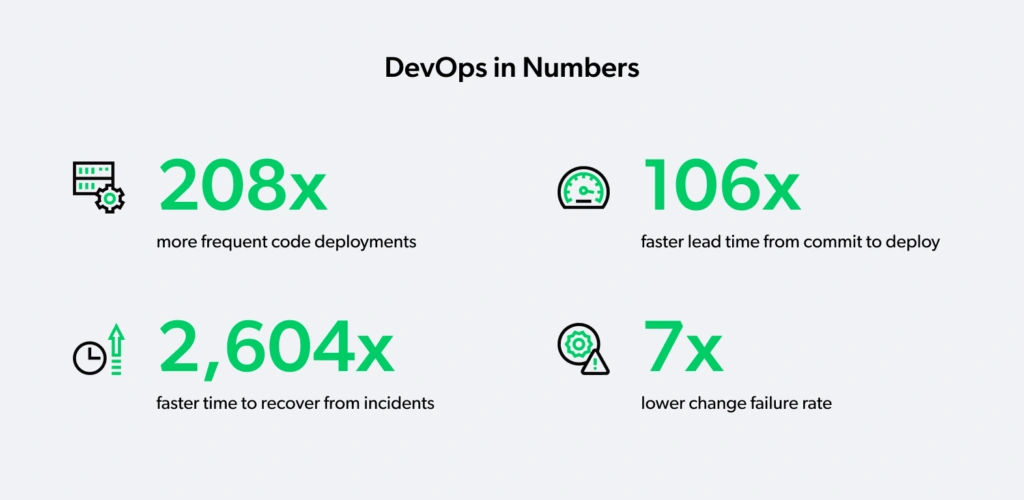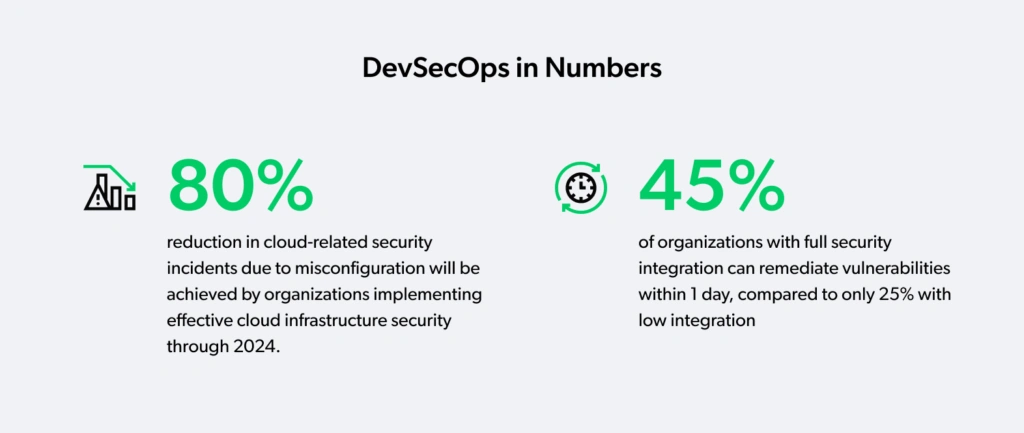In the contemporary landscape of software development, the choice between DevOps and DevSecOps represents a pivotal decision for organizations that are seeking to balance agility and security. DevOps, with its emphasis on collaboration and swift delivery, has proven transformative for many enterprises. DevSecOps integrates security seamlessly into the development lifecycle and it recognizes the imperative of safeguarding digital assets.
This article will dive deep into the DevOps vs DevSecOps debate and it will provide strategic insights and real-world examples. The article’s objective is to guide organizations for selecting the approach that fits their operational and security objectives the best.
What is DevOps?
DevOps is a collaborative software development methodology that emphasizes the integration of development (Dev) and operations (Ops) teams. The goal is to achieve improved efficiency, faster release cycles, and enhanced product quality. It entails the adoption of automation, continuous integration, and continuous deployment in order to streamline the software development lifecycle.
For example, consider a situation where a development team enhances a web application’s features. In a traditional setup, this might lead to delays as the operations team manually configures servers and deploys the updated code. In a DevOps environment, automation tools seamlessly integrate the code changes, run tests, and automatically deploy the application. This reduces manual errors, accelerates the delivery process, and it ensures a more reliable and consistent software release.

Benefits of DevOps
- Faster software delivery. DevOps is like having an exotic car that can get you from point A to point B in no time. Imagine that you’re planning a road trip from New York City to Los Angeles. With a traditional approach, you might need to stop at multiple repair shops along the way to fix breakdowns and address issues. However, with DevOps, you’re driving a high-performance vehicle that’s been meticulously maintained and equipped with the latest technology. This translates into making less stops, a smoother road experience, and a much faster journey.
- Improved software quality. DevOps is like having a team of expert mechanics who meticulously inspect and fine-tune your car. Just as a well-maintained car runs more smoothly and efficiently, high-quality software is less prone to bugs, crashes, and security vulnerabilities. DevOps practices, such as continuous integration and continuous testing, help identify and fix issues early on in the development process. This helps ensure that the software you deliver is polished and reliable.
- Reduced costs. DevOps is like using fuel-efficient tires that save you money on gas. Traditional software development processes can be wasteful and expensive, which often leads to rework, delays, and unnecessary costs. DevOps, on the other hand, promotes automation, streamlined workflows, and a culture of continuous improvement. This results in a more efficient use of resources, reduced costs, and an improved bottom line.
- Increased agility. DevOps is like having a car that can adapt to changing road conditions and can navigate through unexpected detours. In today’s dynamic business environment, organizations need to be agile and adaptable in order to stay ahead of the competition. DevOps fosters a culture of continuous learning and experimentation by enabling teams to respond quickly to changing market demands and customer needs. It’s like having a car that can adjust its own suspension, switch lanes seamlessly, and even drive autonomously when needed.
- Improved collaboration. DevOps is like having a team of pit crew members who work together flawlessly to get your car back on the track. Traditional software development often suffers from silos and communication breakdowns between different teams. DevOps, on the other hand, emphasizes collaboration and integration by breaking down barriers and fostering a culture of shared responsibility. It’s like having a team of experts working together in perfect sync by having each member contribute their own unique skills for achieving a common goal.
- Increased customer satisfaction. DevOps is like having a car that provides a smooth, comfortable, and enjoyable ride. High-quality, reliable software that gets delivered quickly and efficiently leads to happier customers. DevOps practices help organizations meet customer expectations, resolve issues promptly, and it provides a positive user experience. It’s like having a car that not only gets you where you need to go quickly but it also makes the journey enjoyable and memorable.
What is DevSecOps?
DevSecOps, is an abbreviation for Development, Security, and Operations. It’s a collaborative approach that integrates security practices into the software development lifecycle (SDLC) right from the very beginning. Unlike traditional security measures that act as checkpoints after development, DevSecOps embeds security throughout the entire process. This approach ensures that security is not just an afterthought, instead security becomes a fundamental aspect of the software creation process.
DevSecOps is not just about adding more security tools and processes. It’s about changing the mindset of the entire development team. DevSecOps fosters a culture of shared responsibility by encouraging developers, security professionals, and operations engineers to work together seamlessly in order to identify and address security risks early and continuously.

Benefits of DevSecOps
- Proactive security that’s similar to home surveillance. DevSecOps operates as a security system for your software development process in a way that’s like having a comprehensive home surveillance system. Much like a vigilant network of cameras, motion sensors, and alarms that help to avoid potential threats proactively before they materialize, DevSecOps embeds security measures early on in the development lifecycle. Just as a home surveillance system prevents break-ins, DevSecOps prevents vulnerabilities from infiltrating your codebase and it works as a preemptive shield against cyber threats.
- Continuous monitoring resembling health checkups. Imagine DevSecOps as a continuous health monitoring system for your software that’s like individuals getting regular health checkups. Just like routine checkups that can identify health issues early, DevSecOps employs continuous monitoring for detecting and addressing security vulnerabilities in real time. This continuous surveillance ensures that your software remains robust, just like how regular health checkups help contribute to the early detection and prevention of potential health concerns.
- An integrated defense that’s comparable to military strategy. DevSecOps is like a military strategy where the various branches collaborate seamlessly to defend a nation. Similarly, DevSecOps orchestrates the collaboration between development, operations, and security teams in order to create an integrated defense mechanism. This methodology mirrors the military’s coordinated efforts, where air, land, and sea forces all work together to address threats comprehensively. DevSecOps fortifies your digital terrain against a broad spectrum of cyber threats by unifying these domains.
- Agile response similar to emergency services. DevSecOps functions with the agility of emergency services responding to unforeseen incidents. Much like paramedics that swiftly respond to emergencies, DevSecOps ensures rapid identification and mitigation of security incidents. It aligns with the swift response paradigm of emergency services by incorporating security as an integral part of the development process. This agility allows organizations to address security incidents promptly and it helps minimize any potential damage to the software ecosystem.
- Compliance harmony that’s like legal compliance in business. DevSecOps compliance is similar to the meticulous adherence to legal regulations in the business world. Just as businesses navigate complex legal landscapes to ensure compliance with regulations, DevSecOps integrates security practices seamlessly into development workflows. This approach is akin to a business adhering to legal frameworks, not merely as a box-checking exercise, but as an integral part of its operations. DevSecOps ensures that security compliance becomes a harmonious aspect of software development, much like legal compliance does in the corporate realm.
DevOps vs DevSecOps: similarities
DevOps and DevSecOps are two closely related methodologies that strive to improve the software development lifecycle (SDLC) by breaking down the silos between teams and automating processes. While they have distinct goals, they share several key similarities that make them complementary approaches to software development.
- Shared philosophy. Both DevOps and DevSecOps emphasize a culture of collaboration and continuous improvement. They advocate for breaking down the traditional barriers between development and operations teams, which fosters a shared responsibility for the entire SDLC. This collaborative approach leads to better communication, faster problem-solving, and more secure software.
- Emphasis on automation. Automation is a cornerstone of both DevOps and DevSecOps. By automating repetitive tasks, both methodologies reduce manual effort, improve consistency, and it frees up developers and security professionals to focus on higher-value activities. Automation also enables continuous integration and delivery (CI/CD), which allows for faster and more frequent software releases.
- Active monitoring. Both DevOps and DevSecOps prioritize continuous monitoring throughout the SDLC. This includes monitoring application performance, infrastructure health, and security posture. By proactively identifying and addressing potential issues, both methodologies help to prevent downtime, security breaches, and other disruptions.
- Infrastructure as code. Infrastructure as code (IaC) is a common practice in both DevOps and DevSecOps. IaC treats infrastructure resources as code, which allows them to be provisioned, managed, and scaled in a consistent and repeatable manner. This approach enhances flexibility, reduces errors, and it enables the automation of infrastructure deployments.
- Shared goals. Despite their different emphases, DevOps and DevSecOps share the ultimate goal of delivering high-quality software that is secure, reliable, and meets user needs. By breaking down silos, automating processes, and emphasizing collaboration, both methodologies contribute to a more efficient and secure software development process.
In summary, it’s not DevOps vs DevSecOps because they are not mutually exclusive but rather complementary approaches to software development. By embracing both methodologies, organizations can achieve faster, more secure, and more reliable software delivery.
DevSecOps vs DevOps: the differences
In the battle DevOps vs DevSecOps, there is no winner, since these two methodologies that shape the modern software development landscape differ in their primary focus and approach to security integration. See the following table for more information about their differences.
| Feature | DevOps | DevSecOps |
| Primary focus | Speed, agility, and reliability of software delivery | Security of software throughout the development lifecycle |
| Security approach | Security is an afterthought | Security gets integrated into the development process right from the beginning |
| Tools | Version control systems, continuous integration continuous delivery (CI/CD) tools, infrastructure automation tools | Security testing tools, vulnerability scanning tools, security automation tools |
| Roles | Developers, operations engineers | Developers, operations engineers, security engineers |
| Process | Iterative and incremental | Agile and secure |
| Benefits | Faster software delivery, reduced costs, improved quality | Reduced risk of cyberattacks, improved security posture |
| Challenges | Cultural change, resistance from security teams | Integration of security into the development process, shortage of skills |
DevOps vs DevSecOps: which methodology suits you best?
We have prepared for you a DevOps vs DevSecOps table that can help you find out which software development approach will suit you best. Mark in color according to each point which approach fits you more, and find out the result.
| Question | DevOps | DevSecOps |
| Project size and complexity | Suitable for small to moderately complex projects | Suitable for large and complex projects |
| Team experience | Requires prior experience with DevOps principles and practices | Requires prior experience with DevOps principles and practices as well as security expertise |
| Organizational culture | Best suited for agile and open-to-change organizations | Suitable for organizations with varying cultures |
| Security requirements | May not be sufficient for organizations with strict security requirements | Ensures security throughout the development lifecycle and addresses security requirements effectively |
| Budget and timeline constraints | May be more cost-effective and time-efficient for small projects | Requires additional investment in security tools and training but it can save on costs in the long run |
| Compliance requirements | May not fully address compliance regulations | Helps ensure compliance by integrating security into the development process |
| Risk tolerance | May be less suitable for risk-averse organizations | Suitable for organizations with a moderate risk appetite |
| Organizational goals | Primarily focused on improving development speed and agility | Primarily focused on improving security posture while maintaining development agility |
| Tools and infrastructure | Requires appropriate DevOps tools and infrastructure | Requires additional security tools and integration with DevOps tools |
| Organizational processes | May need process adjustments to align with DevOps principles | Requires integration of security practices into existing processes |
| Metrics | Tracks DevOps metrics such as deployment frequency and lead time | Tracks both DevOps and security metrics to assess overall performance |
| Communication channels | Requires open communication to promote DevOps adoption | Requires clear communication to ensure alignment between development and security teams |
| Training and development resources | Requires training on DevOps principles and practices | Requires training on DevOps and security principles and practices |
| Change management processes | Requires a structured change management approach to minimize disruption | Requires a robust change management process to ensure smooth integration of security practices |
| Risk management processes | Requires effective risk identification and mitigation strategies | Integrates security risk assessment into the development process |
| Governance processes | Requires alignment with organizational governance frameworks | Aligns security practices with overall governance policies |
| Monitoring and reporting processes | Tracks DevOps performance metrics | Tracks both DevOps and security metrics to provide comprehensive insights |
Conclusion
We believe that the future of software development lies in the harmonious convergence of DevOps and DevSecOps. Organizations that embrace this synergy can reap the benefits of both methodologies and deliver secure, high-quality software at an unprecedented pace. Our commitment is to help organizations achieve this synergy by providing the expertise, tools, and support they need to navigate the crossroads of speed and security.









